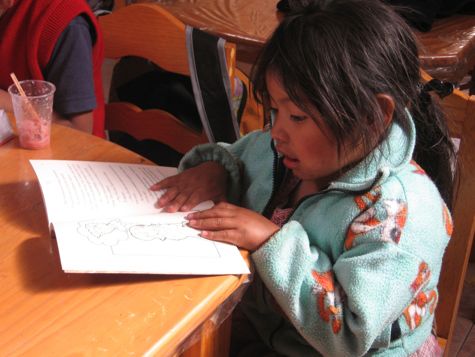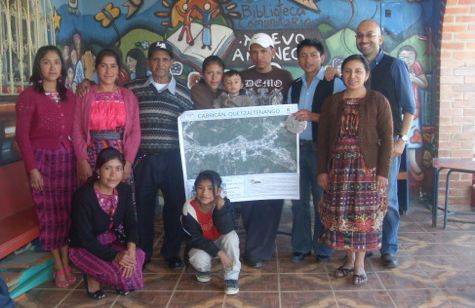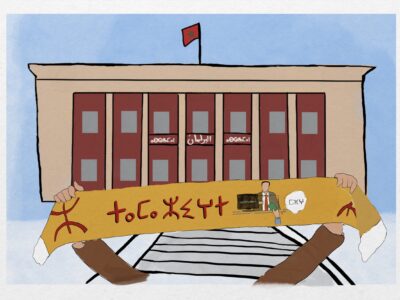Following our project summary of the Rising Voices grantee project Xela Civic Libraries over the past year, we take a look at some of the content created in each of the three community libraries in Quetzaltenango, Guatemala. These blog posts are snapshots of daily life taking place at the library and in the surrounding community.
San Carlos Sija
Librarian Paola Vásquez from the Community Library Fuente de Sabiduría has been sharing blog posts with pictures about some of the ongoing activities for users or all ages. One of these activities is the monthly Women's Goup meetings, where town residents gather to talk and take part in workshops with topics that discuss health, self-esteem, sewing, and other artisanal crafts. Education plays important role at the library through its offering of early childhood education activities and classes to preserve the indigenous K'iche’ language. Vásquez writes, “After seeing that our ancestral languages are disappearing, the Library has taken the initiative to implement a language school in the community to strengthen the importance of maintaining and practicing the mother tongue.”
The blog also features short profiles on some of the library users, including this introduction to one of the library's youngest users, four year-old Dayanci:
Mientras su mami se dedica a la venta de pollo en el mercado municipal de San Carlos Sija, Dayanci se ha convertido en una usuaria de la biblioteca, nos visita diariamente y ha tomado un especial afecto por los libros, ella representa a la cantidad de niños y niñas que recibimos todos los dias y que han encontrado en la biblioteca un lugar de distracción y aprendizaje. Dayanci es una de las tantas personas que nos enseñan diariamente el valor de la perseverancia. Ella debe viajar un promedio de dos horas de ida y vuelta, cada día para acompañar a su mamá que lucha por el sostenimiento económico de su hogar.
Huitán
Natural disasters and other unfortunate accidents are often the talk of the town. Librarian Román Díaz uses the blog of the Community Library Mi Nuevo Mundo to document how these events affect the local community. In March 2013, a truck transporting food items overturned leaving three people injured, who were attended to by local residents until medical personnel arrived at the scene.
However, he also shares good news, such as the recent donation of computer hardware and new books to the library allowing it to expand its services to the general public.
The cultural significance of the area surrounding Huitán is also of great importance to the community. Díaz shares the story of the declining state of the gravesite of an important figure in local history. Kaib’il B’alam was the King of the Mam people in the 16th century, and was killed during the defense of his people against the invasion of the Spanish. Díaz writes that this sacred site should be better preserved, and writes that:
fue un personaje muy querido, que dio su vida para defender el territorio Mam. Actualmente sus restos descansan en el Cerrito conocido actualmente como La Tumba de Kaib’il B’alam. Que ahora ha sido un lugar en donde los Sacerdotes Mayas de diferentes lugares circunvecinos realizan Ceremonias Mayas.
A este cerro actualmente se ha descuidado, no se le ha dado un buen mantenimiento, en su alrededor ha sido como un lugar donde se tira basura. El camino que se dirige hacia la cima del cerro cada año se queda menos transitable debido a los deslaves.
¿Qué podemos hacer para este cerro tan sagrado y tan descuidado pueda ser un lugar reconocido a nivel mundial?
What can we do so that this sacred mountain, which has been so neglected, becomes a place that is known worldwide?
Cabricán
The prime location of the Community Library Nuevo Amanecer along the main plaza in the town of Cabricán gives it a unique perspective on the activities taking place along its streets. Special occasions such as student award ceremonies and school band competitions bring out the entire town to see what is happening. Librarian Isabel Ramos has her camera nearby to capture some of these moments to share on the blog.
Getting to know the surrounding community was one of the main reasons that the Library participated in a GPS mapping project, which was shared to the community at a special event held at the library.
Ramos also explains one of the most popular games using “canicas” (marbles) played by children at the library:
Ya que es un juego muy practicado por la comunidad donde los niños y jóvenes pueden tener más habilidad numérica. Para practicar este juego se hace de la siguiente manera, pueden jugar 4 a 5 niños donde ellos forman un círculo ya estando formado el circulo ellos se enumeran para poder ganar la ficha o otra canica así sucesivamente ellos van jugando. Es un juego que está dentro de la cultura mam y asido practicado por muchas generaciones.





